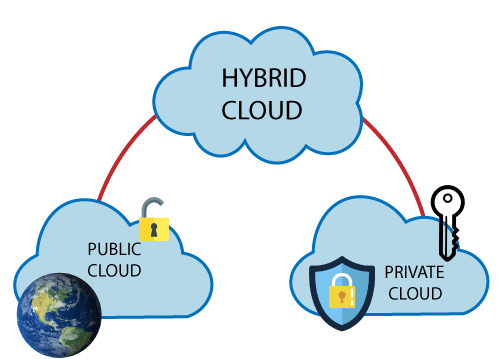
Hybrid cloud refers to a mixed computing, storage, and services environment made up of on-premises infrastructure, private cloud services, and a public cloud—such as Amazon Web Services (AWS) or Microsoft Azure—with orchestration among the various platforms. Using a combination of public clouds, on-premises computing, and private clouds in your data center means that you have a hybrid cloud infrastructure.
Hybrid cloud benefits
Although cloud services can drive cost savings, their main value lies in supporting a fast-moving digital business transformation. Every technology management organization runs under two agendas: the IT agenda and the business transformation agenda. Typically, the IT agenda has been focused on saving money. However, digital business transformation agendas are focused on investments to make money.
The primary benefit of a hybrid cloud is agility. The need to adapt and change direction quickly is a core principle of a digital business. Your enterprise might want (or need) to combine public clouds, private clouds, and on-premises resources to gain the agility it needs for a competitive advantage.
Public cloud: Advantages and disadvantages
If you contract with a service provider such as AWS or Azure, you’re using a public cloud and essentially renting a slice of their distributed data center infrastructure. Public clouds deliver cloud infrastructure as a service (IaaS). They offer massive economies of scale, scale elastically, and run fully automated, so it’s nearly impossible for an on-premises data center to compete on price or efficiency.
Advantages:
- Scalability (both up and down).Almost unlimited due to on-demand cloud resources.
- Lower capital expenditure (capex).You don’t need to purchase all your own data center equipment.
- Due to services distributed across multiple data centers.
Disadvantages:
- Less control over data security.You never know where—and under what geographic or other restrictions—your data is operating.
- Higher operational expenditure (opex).As you scale performance, your cost-per-hour fees rise.

Private cloud: Advantages and disadvantages
If you set up a dedicated cloud infrastructure for your enterprise, you are using a private cloud. It’s a private cloud whether you manage it yourself or hire a third-party service, and whether you host it in your data center or off-premises.
Advantages:
- Your data and applications remain behind your firewall and are accessible only to your enterprise—making private clouds better suited for processing or storing sensitive data.
- Potentially lower TCO.Through lower opex over time.
- Greater control and customization.Fit your servers to your enterprise’s preferences.
- Ability to move non-sensitive data to a public cloud to accommodate sudden bursts of demand on your private cloud.
Disadvantages:
- Higher costs.Increased initial charges and the need to repay costs of the equipment you purchase.
- For operating and maintaining your own data center, IT hardware, and enterprise software—as well as your own security and compliance.
- Less flexibility.In scaling IT resources up or down as your needs change.
Is hybrid cloud right for you?
Not everything belongs in a public cloud, which is why so many forward-thinking companies are choosing a hybrid mixture of cloud services. Hybrid clouds offer the benefits of both public and private clouds and take advantage of existing architecture in a data center.
The hybrid approach allows applications and components to interoperate across boundaries (for example, cloud versus on‐premises), between cloud instances, and even between architectures (for example, traditional versus modern digital). The same level of distribution and access flexibility is also needed for data. Whether you’re handling workloads or datasets, in the dynamic digital world, you should plan for things to move around in response to evolving needs. Where applications or data live today might not be the best place for them to live over time.
A hybrid cloud architecture includes these characteristics:
- Your on-premises data center, private and public cloud resources, and workloads are tied together under common data managementwhile staying distinct.
- You can connect existing systems running on traditional architectures that run business-critical applications or contain sensitive data that might not be suited for the public cloud.
Hybrid cloud infrastructures are enabled by a Data Fabric, which uses a software-defined approach to provide a common set of data services across any combination of IT resources.

Hybrid cloud scenarios
- Dynamic or frequently changing workloads.Use an easily scalable public cloud for your dynamic workloads, while leaving less volatile, or more sensitive, workloads to a private cloud or on-premises data center.
- Separating critical workloads from less-sensitive workloads.You might store sensitive financial or customer information on your private cloud, and use a public cloud to run the rest of your enterprise applications.
- Big data processing.It’s unlikely that you process big data continuously at a near-constant volume. Instead, you could run some of your big data analytics using highly scalable public cloud resources, while also using a private cloud to ensure data security and keep sensitive big data behind your firewall.
- Moving to the cloud incrementally, at your own pace.Put some of your workloads on a public cloud or on a small-scale private cloud. See what works for your enterprise, and continue expanding your cloud presence as needed—on public clouds, private clouds, or a mixture of the two.
- Temporary processing capacity needs.A hybrid cloud lets you allocate public cloud resources for short-term projects, at a lower cost than if you used your own data center’s IT infrastructure. That way, you don’t overinvest in equipment you’ll need only temporarily.
- Flexibility for the future.No matter how well you plan to meet today’s needs, unless you have a crystal ball, you won’t know how your needs might change next month or next year. A hybrid cloud approach lets you match your actual data management requirements to the public cloud, private cloud, or on-premises resources that are best able to handle them.
- Best of both worlds.Unless you have clear-cut needs fulfilled by only a public cloud solution or only a private cloud solution, why limit your options? Choose a hybrid cloud approach, and you can tap the advantages of both worlds simultaneously.
